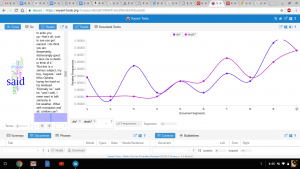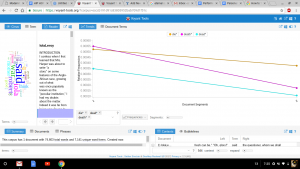As mentioned in class, my project aims to track the frequencies at which death appears in late nineteenth-century American literature. For the purposes of this project, the American Civil War will act as a pivot point from which I will examine works of literature published prior to and post 1861. This is all in an effort to see if American writers were engaging with death differently after the Civil War than they were before. I am not arguing that the Civil War caused a shift (if there even is one) in American’s writers’ perception of death. However, I am interested in taking a look at how works of fiction that explicitly deal with slavery and black life engage with death during this time period. To that end, the first book I will be examining is Uncle Tom’s Cabin.
Below is a graph depicting the frequency with which the words death (including all its tense variants) and die (including all its tense variants) appear in the text. There are obvious shortcomings to this approach. Examining the frequency of the word death is not the same as examining scenes of death in the novel (which may be considered a more accurate in terms of reading the text). However, I do think there is something to be gained from an examination of the word frequency, especially given the results of the graph. Though, I will say that I don’t view this project as replacing a conventional close reading of the text. Rather, I view this project as productively supplementing a close reading of late nineteenth century American lit.
The blue and purple lines represent the frequency with which the words death and die appear in the text. For this graph, the text was split into ten sections and as you can probably tell, the general trend for both words is upward. This becomes clearer if you divide the text into two sections like I did in the graph below. 
Not only are both words ascending, but, despite beginning at different points on the graph, the both appear with about the same frequency by the end of the text. An argument can be made that, based on these graphs, Uncle Tom’s Cabin becomes more concerned with death as you move through the book. This makes sense when we consider the events of the novel. We may be able to attribute this to conventional narrative style where major themes of any given text usually comes to a head at the end of the narrative. This might be due to the nature of slavery and black life as a subject. There are any number of reasons as to why the graph is trending upward. I am curious to see if this trend continues in novels about slavery and black life published before the Civil War.
Tracking Death Pt.2
The above screen shot is a graph of William Wells Brown’s Clotel (A text published before the Civil War). Interestingly it follows the trend of Uncle Tom’s Cabin (another pre Civil War text) in that as you move further into the narrative, the story becomes more concerned with death. The other two terms mostly remain the same.
The above screen shot is a graph of Iola Leroy (a text published after the Civil War), and interestingly, Iola Leroy seems to follow the same trend as Adventures of Huckleberry Finn.
These two graphs help validate my early thoughts going into this project. There does seem to be an empirical difference in the way writers are engaging with the theme of death before and after the Civil War.
Tracking Death pt. 3
Here is, more or less, what my final graph will look like
All four novels are graphed on the above chart and they are charted in chronological order. The word that’s being tracked is “death.” Interestingly, the graph takes the shape of two, more or less, symmetrical hyperbolas. The finished product will include a few more terms, but this stand-alone graph makes me want to rethink the initial question that prompted this entire project. I’ll delve into this in my final write up for the class.



